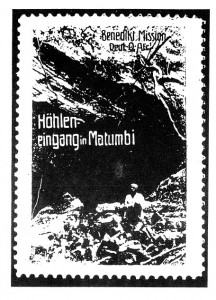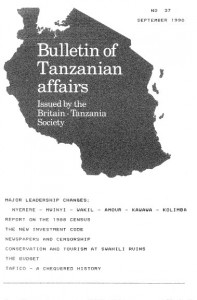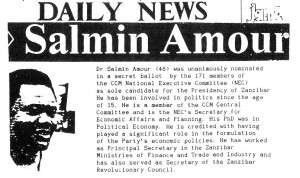INVESTMENT CODE IS NICE AS FAR AS IT GOES
Under this heading AFRICAN BUSINESS in its July 1990 issue stated that 1I1any businessmen in Dar es Salaam had welcomed the new Investment Code (analysed in Bulletin No 37). While many felt that it could have offered more carrots, it represented a crucial break with the past and thus an important beginning. The new code was said to have offered few new guarantees to investors but had restated the constitutional position that no property could be nationalised without compensation. Tanzania would be joining the International Centre for the Settlement of Investment Disputes (ICSID) as well as the World Bank’s Multilateral Investment Guarantee Agency (MIGA). A local business consultant was quoted as having said that potential investors had nothing to fear. Tanzania was undergoing fundamental changes.
THE GENESIS ARCHIPELIGO
‘One hundred years ago Baron Adalbert Emil Redcliffe le Tanneur von Saint Paul-Illaire, the Governor of German East Africa (later Tanzania) found a pretty blue-flowered plant growing around limestone out crops near Tanga … he posted some seeds to his father who grew the plant … and in turn sent some seeds to the Royal Botanic Gardens at Herenhausen. The first of those plants to flower were exhibited lit the International Horticultural Exhibition of 1893 in Ghent under the name Saintpaulia ionantha – the African violet.’ Thus began an article by Jonathan Kingdon in the May 1990 issue of BBC WILDLIFE.
The article went on to describe how the Tanga region was later taken over by estates and the plant became extinct in its original habitat. The wild Saintpaulia was then lost to science for several decades until , in 1985, it was rediscovered by John Lovett in the Uzungwa mountains 300 miles from the place where it had been found originally.
In October 1989 the Society for Environmental Exploration (Bulletin No 35) enabled Jonathan Kingdon to visit Tanzania and in particular the Matumbi range of sandstone hills close to the Indian Ocean. He found a second surviving population of African violets . He went on to explain why he expected he might find the violet there and compared and contrasted what he described as ‘stable’ as distinct from ‘fluctuating’ habitats in many other parts of Africa. He stated that about a quarter of Africa’s species are clustered in old enclaves with stable climates. He concluded by referring to the ‘profligate and irreversible waste’ now occurring in the Matumbi forest and the need for conservation of the remaining forest.
THE POPE IN TANZANIA
Commenting on the Pope’s frequent use of Kiswahili during his visit to Tanzania for three days from September 2, 1990 one local priest said he “sounded like a foreigner who had lived in Tanzania a long time” (UNIVERSE September 9, 1990).
This visit gave Tanzania much greater publicity in the international press than it is accustomed to.
The DAILY TELEGRAPH: ‘Pope’s Call to Shun Condoms Fuels AIDS Row’ According to the Telegraph the Pope had declared in Dar es Salaam that condoms would only encourage – the very patterns of behaviour which have greatly contributed to the expansion of the disease”
The French newspaper LIBERATION: ‘Jean Paul II Face a L’Afrique Qui Bouge’: ‘Addressing 80,000 people in Dar es Salaam yesterday the Pope ordained 43 new priests who would help to ‘prepare the African Catholic Church for the third millennium.’
The NEW YORK TIMES wrote of the Pope’s intention to prepare an encyclical reinforcing the Catholic Church’s hostility to all forms of contraception.
The London TIMES: ‘Pope Calls for Moral Drive Against AIDS.’ The Pope arrived at the Jangwani sports ground to the rhythms of Swahili hymns and traditional drums. As he drove through the crowd in an open black Rolls Royce the huge congregation rose to its feet , ululating, clapping and waving ….
UNIVERSE: ‘AIDS Cure Rivalry Must End’ . “AIDS brings a unique cultural unease because in it the life giving functions of human sexuality, and the blood which epitomises health and life itself, have become a roadway to death”. The Pope praised the rapidly growing Church in Tanzania for its ministry to the sick and needy and for its overall spiritual vitality.
The DAILY TELEGRAPH: ‘Africans Flock for Pope’s Blessing’. Father Giorgio Battifolo, an Italian who has been working In Tanzania for 36 years, said “I never thought to live to see this. It’s beautiful. This is a great reward for the early missionaries who had so many difficulties~
BUSINESS AS USUAL
Reviewing police efforts to deal with the problem of prostitution in Dar es Salaam during the last eighteen months, AFRICAN CONCORD in a recent issue, described how the Police had launched a major campaign at the end of 1989. About 100 prostitutes had been rounded up and within days some 50 had been sentenced to prison for six months. Several others were fined and the youngest and oldest were placed under the care of the social welfare services. But the nation, led by fervent feminist groups, reacted angrily, saying it was unfair for the Police to carry out a one-sided scoop, singling out women and leaving behind their male counterparts. AFRICAN CONCORD said that it believed that the women had eventually received a Presidential pardon. As one of them put it recently “it is now business as usual”.
NEW APPROACH TO CRAFTS PROMOTION
‘Almost everywhere in tropical Africa where there are ore deposits, iron ore is produced. The Negro possesses a marked talent for working iron. Reportedly, even entire rifles have been fabricated including the bores for the barrels’ . With this quotation from a 1910 document entitled ‘Handicraft and Industry in East Africa’ a recent issue of the German publication AFRIKA reviewed historically the work of craftsmen in Africa with particular reference to Tanzania.
‘Colonialism based on the primitive exploitation of men and raw materials afforded traditional crafts no new opening or markets … Liberation brought no improvement – traditional artisans ‘under a tree’ were viewed by the new elites as a sign of backwardness and underdevelopment …..
Far more than churches, schools, or health centres, the structures that Strike the eye in rural Tanzania are the water tanks. These are all so sophisticated in their design that maintenance and repair can only be carried out by specialists with modern equipment … hardly any system of water supply is today operational except where a new development project has been initiated to rehabilitate the dilapidated water tanks.
For years now efforts have been made to develop appropriate technologies for the Third World. The spread effect has remained minimal for various technical, economic and ideological reasons …
But in Singida, the Usambara mountains and Morogoro a new approach to craft promotion has begun in arrangements made in partnership with the churches. The key concept is that promotion should be directed at existing, local workshops … aid donors provide direct business consultancy in conjunction with credit facilities and flexible individual training of craftsmen. Particularly successful is the Crafts and Artisans Promotion Unit (CAPU) set up in Singlda. In the first phase the craftsman is provided with what he needs to fabricate axes, hoes, knives, spears, arrows etc with new tools in a more rational manner. In the second phase … a workshop is constructed and provided with manual machines … In the third phase new technologies are introduced.’
FOREST CONSERVATION MEASURES
The German publication AFRIKA (9-10/90) stated th8t Tanzania had launched ‘a fire and environment war’ to reduce the damage caused by bush fires and discourage firewood 8nd charcoal use. Tanzania’s trees, which supplied 90% of domestic fuel requirements, were being felled at an annual rate of 300-400,000 hectares and another 65,000 hectares were destroyed by fire each year. New planting accounted for only 20,000 hectares.
New measures included taking tax off electric, gas and solar stoves, a ban on charcoal exports, extra fire fighting units, more patrols and a public awareness campaign.
BODIES ROT
Under this heading AFRICA HEALTH in its September 1990 issue reported that in Bukoba, one of the districts worst affected by AIDS, a major problem has arisen in the disposal of bodies of people who have died from the disease. Relatives often do not come to collect bodies for burial. The Red Cross has provided 2,400 metres of shroud cloth to the Kagera Regional Hospital which has no cold room.
ANC EXILES STAY ABROAD
NEW AFRICAN in its November 1990 issue wrote that many South African exiles were having second thoughts about returning home due to the instability and violence there. In Tanzania, it stated, ‘where most of the exiles found refuge, about 50 school teachers are known to have applied for jobs … Over 200 South African students have just joined the Soloman Mahlangu Freedom College in Tanzania because there are no alternatives at home.’
HOMECOMING
The Tanzanian writer Adam Lusekelo has been spending a year working with the BBC in London. He wrote in the November-December 1990 issue of the BBC magazine FOCUS ON AFRICA about his ‘homecoming’:
‘Sweltering Dar es Salaam. The sun burns you as you walk down the busy Samora Machel Avenue – now avoiding a heap of rubbish, now making a minor Olympic record as you jump over a pot-hole. Pretty damsels walk the opposite way but you ignore them. AIDS. But you are home again. It feels good ….
A friend hails me from across the street. “I say. When did you come?” You tell him that you came back four months ago … “Have you been to the Kremlin?” he suggests. .. Kremlin?” “Yeah. In Moscow. It’s a nice place. You can get roast chicken. Goes down well with ugali. There are also some very cold beers there.” So you take a cab to Kinondoni shanty township – the people there call it Moscow. The cab would have made Peugeot manufacturers pleased with themselves – if that is, they are still alive …. the friend takes out a packet of cigarettes. “Don’t” yells the driver.
“Why?”
“This car will explode” he says. You agree from the smell of petrol that is getting increasingly intolerable. The Kremlin is full of youngish men and women …
“Back to TZ, eh? We’ll see about those fancy shirts you are wearing. They will fade. And that hair will turn red. You see, God has lowered the sun by an inch or two. And those nice smells you are wearing will disappear. You will end up smelling of good old Tanzanian sweat…
STATISTICS FOR 185 ECONOMIES
WORLD BANK NEWS in its September 26, 1990 issue compared and contrasted statistically the economies of 185 countries. Tanzania’s GNP in 1989 was given as US$ 3,079 compared with US$ 3,775 in 1988. Its growth rate for the period 1980 to 1989 averaged 1.8% (compared with a population growth rate of 3.5%). Tanzania’s GNP per capita was US$ 120 in 1989 – equivalent to a real growth rate between 1980 and 1969 of minus 1.6%. Tanzania came out at the very bottom of the list in terms of GNP per capita. Only Mozambique with a figure of US$ 100 came lower. Ethiopia was said to have had the same rate as Tanzania in 1989 – ie: US$ 120.
The United Kingdom had a GNP of US$ 834,166 in 1989 equal to a per capita GNP of US$ 14,570. The figures for the United States were US$ 5,237,707 or US$ 21,100. Other African country GNP’s per capita were given as: Kenya US$ 380, Angola US$ 620, Botswana US$ 940, Burkina Faso US$ 310, Cote d’ Ivoire US$ 790, Gabon US$ 2,770, Gambia US$ 230, Lesotho US$ 470, Malawi US$ 160, Nigeria US$ 250, South Africa US$ 2,460 and Swaziland US$ 900.
DEFICIT IN ACCOUNTANTS
A national campaign by the accountancy profession in Tanzania over the last five years has successfully resulted in the 460 parastatal organisations bringing their accounts up to date according to E. B. Mndolwa writing in the September 1990 issue of CERTIFIED ACCOUNTANT. At present Tanzania needs some 6,000 – 7,000 qualified accountants and 15 – 20,000 accounting technicians according to the article but the numbers available total only 1,000 and 3,000 respectively.



